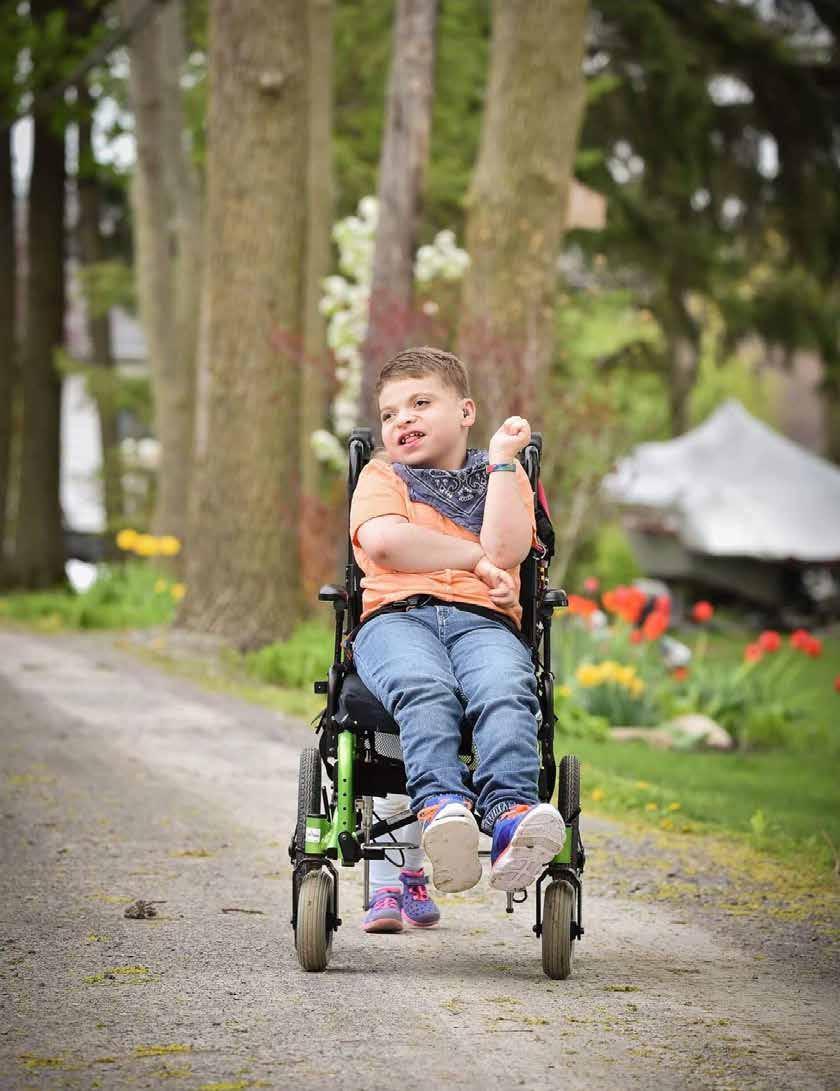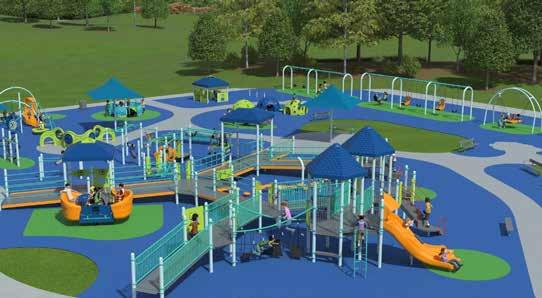
8 minute read
Play space equity
BY NANCY E. MCCARTHY
Play is serious business when it comes to healthy child development because it is essential to the social, emotional, cognitive, and physical well-being of children.
Advertisement
A playground can be an ideal setting for kids to develop important lifelong skills such as cooperation, overcoming challenges, fostering relationships and creativity, problem-solving, and negotiating with others. Plus, it’s fun! Let’s not forget that.
Not all children have a neighborhood playground or live near age- or ability- appropriate play spaces. KABOOM! is a national nonprofit that collaborates with funding partners and local community organizations to build safe, fun play spaces that help kids to thrive. Its goal is to end play space inequity for good. KABOOM! defines play space equity as the ability for every child to have access to incredible places to play.

Leveling the playing field

Mike, MJ, and Nanci Bentley
LOCAL IMPACTS
The Play Everywhere Design Challenge (PEDC), launched in 2018, is an ongoing partnership between KABOOM! and one of its lead funding partners, the Ralph C. Wilson, Jr. Foundation (RCWJRF). Because RCWJRF focuses on Western New York and Southeast Michigan, PEDC invites collaborating agencies from these areas to submit creative ideas that turn everyday spaces into play spaces. Grants are awarded annually to selected projects. The winning teams and their design partners then build the public installations.
In 2018, the Healthi Kids initiative at Common Ground Health (CGH) won a PEDC grant that, along with an additional donation from Excellus Blue Cross Blue Shield and in-kind support from CGH, City of Rochester, and Central Library of Rochester & Monroe County, funded the PLAY Walk in downtown Rochester. This interactive trail is located along Chestnut and Court Streets between the Central Library and the Strong National Museum of Play. The PLAY Walk features permanently installed large-format games and activities such as a distortion mirror, foosball table, four-in-a-row game, and musical instruments.
“Research from the Healthi Kids coalition demonstrates that not every child in the City of Rochester has access to safe and accessible play spaces and that over eighty-two percent of our children do not play in parks and playgrounds” says Jenn Beideman, advocacy manager at Common Ground Health in Rochester. CGH’s mission is to bring greater focus to community health issues through data analysis, resident engagement, and solution implementation via regional collaboration and partnerships. “We have to re-think our urban landscape to provide those safe and accessible play spaces for kids at the places they already are playing,” she says. Play everywhere infrastructure like the PLAY Walk turns an ordinary walk down the street into an extraordinary opportunity for play and exploration.
In 2019, Healthi Kids applied and received a second PEDC grant to add the Ripple, a new interactive attraction to the PLAY Walk that was installed this past May. Inspired by the flowing motion of the Genesee River, these large sculptural installations are comprised of colorful wavy rows of small 3-D panels resembling a lilac flower. People can rotate the panels to reveal different pixelated illustrations and colors that constantly change due to light reflection and refraction. Based on input from children at Central Library’s Teen Center, the Urban Conga design studio constructed the Ripple, which is located by Martin Luther King Jr. Memorial Park.
KABOOM! announced the new winners of the 2020 Play Everywhere Design Challenge grants in February 2021, which

Advocacy Manager Jenn Beideman at ribbon cutting ceremony for the Ripple

One of the GIANT Room's "STEAM" craft kits

Canandaigua playground rendering

The Ripple, a new addition to downtown Rochester’s Play Walk
included more Rochester projects. The Central Library will upgrade the Secret Room in its Children’s Center with a new, multi-functional design. University of Rochester partnered with the 540WMain organization (its focus is neighborhood revitalization and social justice programming) to build an innovative and wheelchair-accessible outdoor play space in the city’s 19th Ward on an empty lot near School 29. “School 29 has a greater than fifty percent disabled student population, so our project is evolving to really value accessibility in a way that I think is ... unique,” says Shannon Lue Chee Lip, project manager.
Both initiatives’ designs received input from the children and families living in the neighborhoods who will use the spaces.
Another 2020 Rochester grant was awarded to fund STEAM in Everyday Moments craft kits. This project is the brainchild of the GIANT Room and Generation Two (G2). The GIANT Room is an innovation studio for kids, offering creative programs and classes rooted in Science, Technology, Engineering, Arts, and Mathematics (STEAM). G2 is a nonprofit that fosters intergenerational friendships and child advocacy partnerships through child-directed play. The GIANT Room designed, fabricated, and filled themed craft kits with materials appropriate for children ages four to eight. G2 distributes them in everyday places like cafes, laundromats, and barber shops. Other community organizations serving children can also request kits directly from G2.
“The play kits differ from our traditional playground build model but fit right along with the idea of Play Everywhere, which aims to be very responsive to the community’s needs and embed play into the community in non-traditional ways,” says Jen Hallaman, KABOOM!’s senior manager, strategic communications.
PLAY DESERTS
Common Ground Health led a mapping project to identify “play deserts” across Rochester, where concentrations of kids are growing up without access to a park or recreation center within a quarter-mile walking distance. They paired this data with insights from city departments, their staff, youth-serving organizations, and local parents and kids to select a project and apply for a national KABOOM! grant. Three grants would be awarded to three different communities.
The grant criteria were based on the specific need for a play space, a plan for a playground-building service event that would engage community members and organizations in the process, and how this project would address play space equity issues in the community.
In 2019, Rochester was awarded one of the grants. ROC the Future partnered with CGH and identified Grand Ave Park in Rochester’s Beechwood neighborhood as a site to build an adventure course for teenagers. In the City of Rochester Beechwood is at the eleventh percentile of opportunity, creating a severe disadvantage for housing stability, education, health and well-being, mobility, and economic security. Targeting a space for teenagers aligns with ROC the Future’s focus on improving academic outcomes— including high school senior graduation rates through its mentoring programs. The Adventure Course goal is to provide a structured, adult-facilitated but youth-led initiative where the teens have a space to connect, challenge themselves, and create measurable change for their community.
Kilolo Moyo-White, ROC the Future’s family and community engagement specialist, says she is “really excited to finally see youth engagement actually happening in the project.” The teen committee provided input into the design and invited over 400 Rochester youth to vote on the final adventure course design. They continue to plan, promote,

Canandaigua playground groundbreaking
and recruit for the ultimate volunteer installation.
Other partners in this effort are the City of Rochester and Connected Communities, a neighborhood coalition. After a year’s pause due to the pandemic, the adventure course build is slated for completion in August.
DREAMING BIG: INCLUSION IN MOTION
With twenty-two city and town parks, there’s no shortage of Canandaigua playgrounds. What Mike and Nanci Bentley found lacking was a play space to accommodate children with special needs, like their ten-year-old son Michael (“MJ”). MJ has Pallister-Killian syndrome, a rare developmental disorder that causes mobility challenges, cognitive delays, and epilepsy.
In 2015, pediatric physical therapist Sonya Smith began working with MJ. “With the pediatric population, we often disguise physical therapy as ‘play,’” says Smith. “There is so much that can be accomplished through targeted purposeful play in terms of improving strength, balance, coordination, and range of motion. Play is motivating and has countless additional benefits for the child.”
But where could MJ and children with other disabilities play? And why weren’t any parks accommodating children of any ability to all play together in one space?
After Nanci learned of a Denver family raising funds for an all-abilities playground, the Bentleys, Smith, and Smith's husband, Corey, became determined to build an inclusive playground in Canandaigua. They formed a committee, started up the Inclusion in Motion (IM) nonprofit, brought their concept to the community, and started the Dream Big fundraising campaign. The project resonated big time. Their goal is $995,000 and with donations from 225 individuals and businesses, plus grants (including KABOOM!), they have raised almost $700,000.
After four years, their mission “to empower all abilities and ages to play, exercise, learn, and socialize together while enriching our community” is nearly fulfilled. In May, the project broke ground on donated land from the Town of Canandaigua, across from Richard P. Outhouse Memorial Park. The two-acre playground will have a fully rubberized surface and is slated for completion this August.
Thanks to a partnership with University at Buffalo’s Center for Inclusive Design and Environmental Access, IM is the only universally designed and certified playground in the United States. Simply stated, instead of just meeting code, universal design strategies are incorporated into everything from site design, parking, paths of travel, and access to restrooms and pavilions. And every piece of play equipment can be accessed by kids of many abilities.
A reminder to us all that the fun part of playgrounds is definitely universal, too.

Bentley family at ribbon cutting










